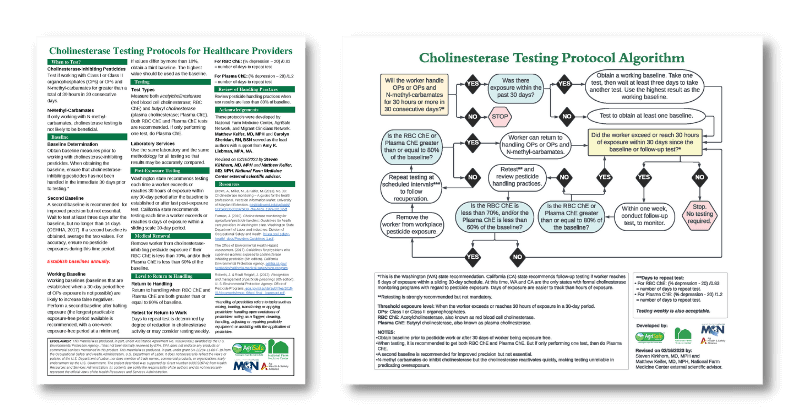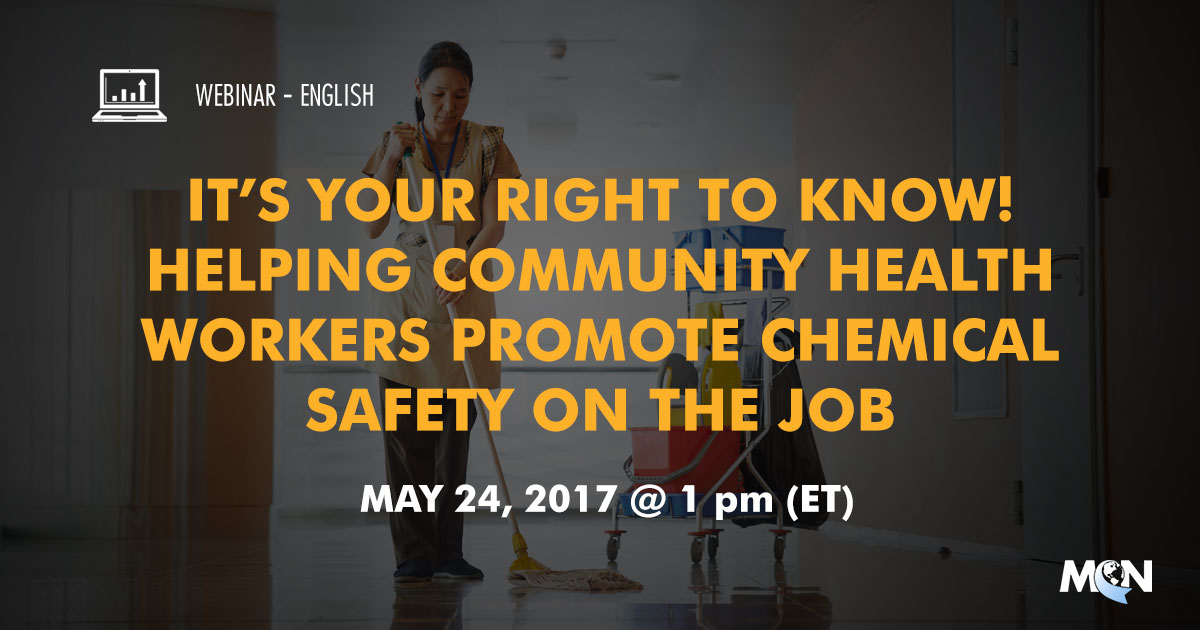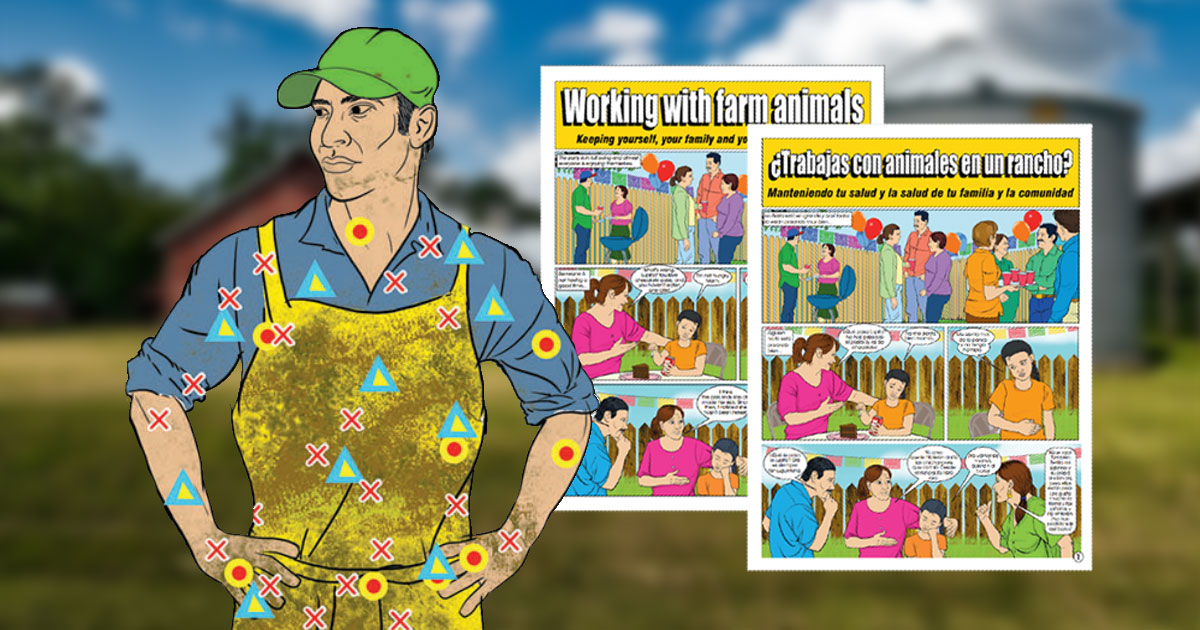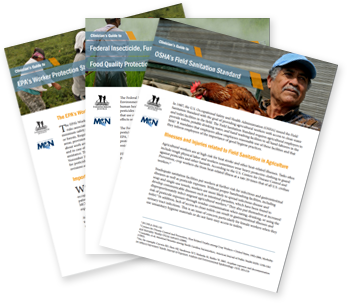
These Cholinesterase (ChE) clinical tools provide a concise and simple format to guide clinicians in monitoring the ChE levels for patients working with Class I and Class II organophosphates (OP) or OP and N-methyl-carbamates.

These Cholinesterase (ChE) clinical tools provide a concise and simple format to guide clinicians in monitoring the ChE levels for patients working with Class I and Class II organophosphates (OP) or OP and N-methyl-carbamates.

FECHA: 11 de Octubre de 2017 @ 1 PM (ET)
PRESENTADORES:
Para recibir credito de Trabajador/a de Salud Comunitaria o Educacion de Continua de Enfermera después de ver alguno de estos seminarios usted debe hacer lo siguiente:
Conforme las familias regresan a sus hogares en Houston, una vez que las inundaciones causadas por los Huracanes Irma y María se van retirando, esto se convierte en una carrera contra el tiempo. Un olor sofocante llena los cuartos de las casas, los charcos permanecen en los pasillos, y el moho se multiplica rápidamente. En cuestión de días, los patios ensopados de los vecinos se convierten en tiraderos de basura, conforme los trabajadores empiezan a quitar de las casas las paredes con moho, los pisos y los cielos destruidos, así como los muebles dañados. En este proceso, los trabajadores y muchos residentes se exponen al agua contaminada con químicos y basura, materiales de construcción peligros y alimañas dañinas. Pero hay otros riesgos adicionales, estructuras inestables y posibles intoxicaciones por monóxido de carbono de los generadores que trabajan incansablemente en espacios con poca ventilación. La exposición a asbestos, sílice y plomo son también peligros comunes para estos trabajadores.
Katrina, Sandy, Harvey, Irma y ahora Maria: son nombres de tormentas que nos indican las diferentes comunidades que terminaron bajo el agua, pero muchas de las historias emanadas de ellas, sobre la limpieza -- y los peligros involucrados-- son las mismas. Con resiliencia y determinación, las comunidades se tratan de reconstruir, pero la reconstrucción necesita una fuerza de trabajo inmediata, lista para este trabajo peligroso y extenuante.
Las operaciones de recuperación después del desastre, limpieza y reconstrucción presentan muchos riesgos y peligros para los trabajadores. Muchos de ellos realizan este trabajo sin el equipo de seguridad o el entrenamiento de mitigación de peligros adecuado.
En la recuperación de una supertormenta, ¿cuáles son las vulnerabilidades que los trabajadores enfrentan y qué significa eso para la seguridad y la salud del trabajador? Las siguientes preguntas surgen para los proveedores y trabajadores de salud comunitarios que cuidan y se preocupan por estos trabajadores: ¿cuáles son los puntos claves que necesitamos entender para poder cuidar de aquellos involucrados en estos esfuerzos de limpieza y reconstrucción? y ¿qué podemos hacer para que ellos mismos prevengan las lesiones y las enfermedades?
Este seminario en línea recupera experiencias obtenidas de desastres naturales anteriores y ofrece recursos que le pueden guiar en su trabajo. Ofreceremos casos reales para ilustrar los peligros y revisaremos formas en que los trabajadores se pueden proteger a sí mismos, incluyendo el entendimiento de sus derechos y responsabilidades.
Este proyecto cuenta con el apoyo de la Administración de Recursos y Servicios de Salud (HRSA) del Departamento de Salud y Servicios Humanos de los Estados Unidos bajo el acuerdo de cooperación número U30CS09742, Asistencia Técnica a Centros de Salud Comunitarios y Migrantes y Personas sin Hogar por $ 1,094,709.00 con 0% del total Proyecto NCA financiado con fuentes no federales. Esta información o contenido y las conclusiones son las del autor y no deben ser interpretadas como la posición o política oficial de, ni cualquier endosos deben ser inferidos por HRSA, HHS o el Gobierno de los Estados Unidos.
Offers basic screening questions, common occupations and ailments associated with them, as well as recommended treatment. Also includes sample letters from clinicians to employers for restricted work.

DATE: May 24, 2017, 1 pm (ET)
SPEAKERS: Juliana Simmons, MSPH, CHES
To receive CME* or CNE credit after viewing this webinar, you must:
José Navarro was excited for his new career after landing a job in the poultry industry. After five years on the job, 37 year-old Navarro began coughing up blood. He died soon after when his lungs and kidneys failed. His death triggered a federal investigation raising questions about the health risks associated with the use of toxic chemicals in poultry plants.
Millions of workers are exposed to chemicals everyday on the job. All workers have the right to know about the chemicals they work with and community health workers can be an important source of information and support for workers. This workshop will teach community health workers how to explain what happens when someone is exposed to chemicals and how workers can best protect themselves
This project is supported by the Health Resources and Services Administration (HRSA) of the U.S. Department of Health and Human Services (HHS) under cooperative agreement number U30CS09742, Technical Assistance to Community and Migrant Health Centers and Homeless for $1,094,709.00 with 0% of the total NCA project financed with non-federal sources. This information or content and conclusions are those of the author and should not be construed as the official position or policy of, nor should any endorsements be inferred by HRSA, HHS or the U.S. Government.
DATE: February 21, 2017
SPEAKERS: Ed Zuroweste, MD
To receive CME* or CNE credit after viewing this webinar, you must:
Agriculture is also one of the most dangerous industries in the United States. For vulnerable populations working in agriculture, their lack of training, poor safety precautions, regulatory exclusions, lack of health insurance, language barriers, piece-rate pay, immigration status, and geographical and cultural isolation can put these workers at increased risk for occupationally related injuries and illnesses and chronic sequelae. Exposure to pesticides and other contaminants is a particular concern to agricultural workers and their families. This continuing education training will discuss health risks facing immigrant and migrant agricultural workers and their families as a result of their working conditions and environment, with a particular focus on Kansas. It will also highlight best practices and resources for the incorporation of environmental and occupational health in the practice setting, showcasing successful initiatives in primary care settings. Participants will explore the importance of and become familiar with the methods to integrate environmental and occupational health into the practice setting from the clinical perspective as well as consider these issues within the framework of social determinants of health.
This material was produced, in part, under Assistance Agreement No. X883487601 awarded by the U.S. Environmental Protection Agency. It has not been formally reviewed by EPA. EPA does not endorse any products or commercial services mentioned in this product.

Libro cómic educativo bilingüe sobre cómo prevenir las enfermedades zoonóticas. Desarrollado por MCN en colaboración con la Universidad Estatal de Ohio.

MCN and Farmworker Justice offer these guides to assist clinicians in understanding farmworker health and safety regulations. OSHA’s Field Sanitation Standard; EPA's Federal Insecticide, Fungicide, and Rodenticide Act (FIFRA); EPA's Food Quality Protection Act (FQPA); EPA’s Worker Protection Standard (WPS).

MCN y Farmworker Justice ofrecen estas guías para ayudar a los médicos en la comprensión de regulaciones de salud y seguridad de los campesinos. Información de los Estándares de Saneamiento de la Administración de Seguridad y Salud Ocupacional (OSHA) para los campos; la Ley Federal de Insecticidas, Fungicidas y Rodenticidas (FIFRA) regulado por la Agencia de Protección Ambiental (EPA); la Ley de la Protección de la Calidad de los Alimentos (FQPA) también regulado por el EPA; y el estándar de protección del trabajador (WPS) establecido por el EPA.

MCN and Farmworker Justice offer these guides to assist clinicians in understanding farmworker health and safety regulations. OSHA’s Field Sanitation Standard; EPA's Federal Insecticide, Fungicide, and Rodenticide Act (FIFRA); EPA's Food Quality Protection Act (FQPA); EPA’s Worker Protection Standard (WPS).
The U.S. Environmental Protection Agency’s (EPA) Worker Protection Standard (WPS) provides basic workplace protections to farmworkers and pesticide handlers to minimize the adverse effects of pesticide exposure. EPA announced major revisions to the WPS in September 2015. MCN and FJ's fact sheet provides a summary of the revised regulation.
http://www.cdph.ca.gov/programs/cosmetics/Pages/default.aspx
An online, searchable database that allows salon workers and others to learn about and report toxic chemicals found in nail salon products and other cosmetics.
http://umash.umn.edu/needlestick-prevention/ This webpage features factsheets and videos developed by the Upper Midwest Agricultural Safety and Health Center (UMASH) to educate farmworkers, producers, and veterinarians about needlestick prevention. Resources are available in both English and Spanish.
Three concise and effective environmental/occupational health screening questions for the primary care provider. English and Spanish. MCN, 2014.
An EHR-friendly version of these screening questions was developed through MCN's Workers & Health Program. This can be used as a reference for integration into the health center's Electronic Health Record.
Print, cut, and distribute this handy bookmark to providers who treat migrant and seasonal farmworker patients. The bookmark includes links and a qr code to connect you to pesticide - related clinical tools and resources. In addition, we've included some useful phone numbers in case of a pesticide emergency.
You can also use the bookmark to keep handy the Health Network phone number to be sure your patients on the move remain in care.
Introduction
In August of 2005, the North Carolina Division of Public Health, Occupational and Environmental Epidemiology Branch (OEEB) was notified that three women who had worked on farms in North Carolina owned by Ag-Mart had delivered infants with birth defects. All three births took place in Florida where the women also worked on Ag-Mart farms and lived near each other. This report summarizes the OEEB’s investigation and assessment of the pesticide exposures likely experienced by these women while in North Carolina.
http://www.farmworkercliniciansmanual.com
This comprehensive manual was developed by the New York Center for Agricultural Medicine and Health and the Migrant Clinicians Network for the diagnosis and treatment of occupational injuries in migrant and seasonal farmworkers. The information in the manual does focus on agricultural occupations in the Northeast.

These Cholinesterase (ChE) clinical tools provide a concise and simple format to guide clinicians in monitoring the ChE levels for patients working with Class I and Class II organophosphates (OP) or OP and N-methyl-carbamates.
This booklet is intended to help Community Health Centers put in place an effective and efficient workers' compensation program.
MCN's Pesticide Clinical Guidelines and Pesticide Exposure Assessment Form assist in the recognition and management of acute pesticide exposures in primary care settings.
The pesticide guidelines were adapted from guidelines developed by Dr. Dennis H. Penzell, a former medical director of a Community and Migrant Health Center with experience in large-scale pesticide exposure incidents.
The Acute Pesticide Exposure Form was adapted from the data collection on an acute pesticide exposed patient tool developed by Matthew C. Keifer, MD, MPH, Director of the National Farm Medicine Center, appearing in the EPA's Recognition and Management of Pesticide Exposures, 6th Edition, EPA 2013.
These resources were developed with guidance from MCN's Environmental and Occupational Health Advisory Committee - a panel of healthcare professionals and researchers with expertise in pesticides and migrant health.
The following documents are a collection of the best resources available for taking a good occupational health history.
Bilingual form to screen pregnant women for lead exposure. Developed by MCN.
Clinicial guidelines dealing with children and lead exposure. Special emphasis on working with migrant children.
Use the link below to access MCN's Rapid Assessment Tool to help adolescent farmworkers identify agricultural tasks they perform in agriculture and facilitate clinician understanding about the health risks associated with it. Youth worker images are adapted and reproduced with permission from the National Children Center for Rural and Agricultural Health and Safety. Images copyrighted through Marshfield Clinic, Marshfield, Wisconsin.
If computers and internet access are unavailable where patient care is provided, the worker assessment sheet and clinician information grid are available in PDF.
http://www.informaworld.com/smpp/title~db=all~content=g924790533
The Journal of Agromedicine published this FREE special issue (Volume 15, Issue 3) that presents papers based upon the research and safety strategies presented at the "Be Safe, Be Profitable: Protecting Workers in Agriculture" conference held in January 2010 in Dallas, Texas. The conference was a joint meeting of the Agricultural Safety and Health Council of America (ASCHA) and the National Institute for Occupational Safety and Health (NIOSH). "It is our hope that this collection of editorials, panel presentations, plenary talks, and poster abstracts stimulates a new order of translational research, leading to effective research partnerships and improved health and safety outcomes," states Editor-in-Chief Steven Kirkhorn.
Do not miss the opportunity to read the results from this groundbreaking agricultural safety and health conference!
California Department of Public Health, Division of Environmental and Occupational Disease Control has identified several cases of mercury toxicity linked to the use of adulterated, unlabelled face creams in the Latino community.
http://www.neefusa.org/health/asthma/asthmaguidelines.htm
These guidelines are aimed at integrating environmental management of asthma into pediatric health care. Offers clinical competencies in environmental health relevant to pediatric asthma and outlines the environmental interventions to communicate to patients.
Continuing education course developed by the Occupational Lead Poisoning Prevention Program, California Department of Public Health. Can view it for information or can register for credits.
The Toolkit is a combination of easy-to-use reference guides for health providers and user friendly health education materials on preventing exposures to toxic chemicals and other substances that affect infant and child health.
A useful resource for health professionals interested in the health effects of exposure to specific chemicals and hazardous substances.